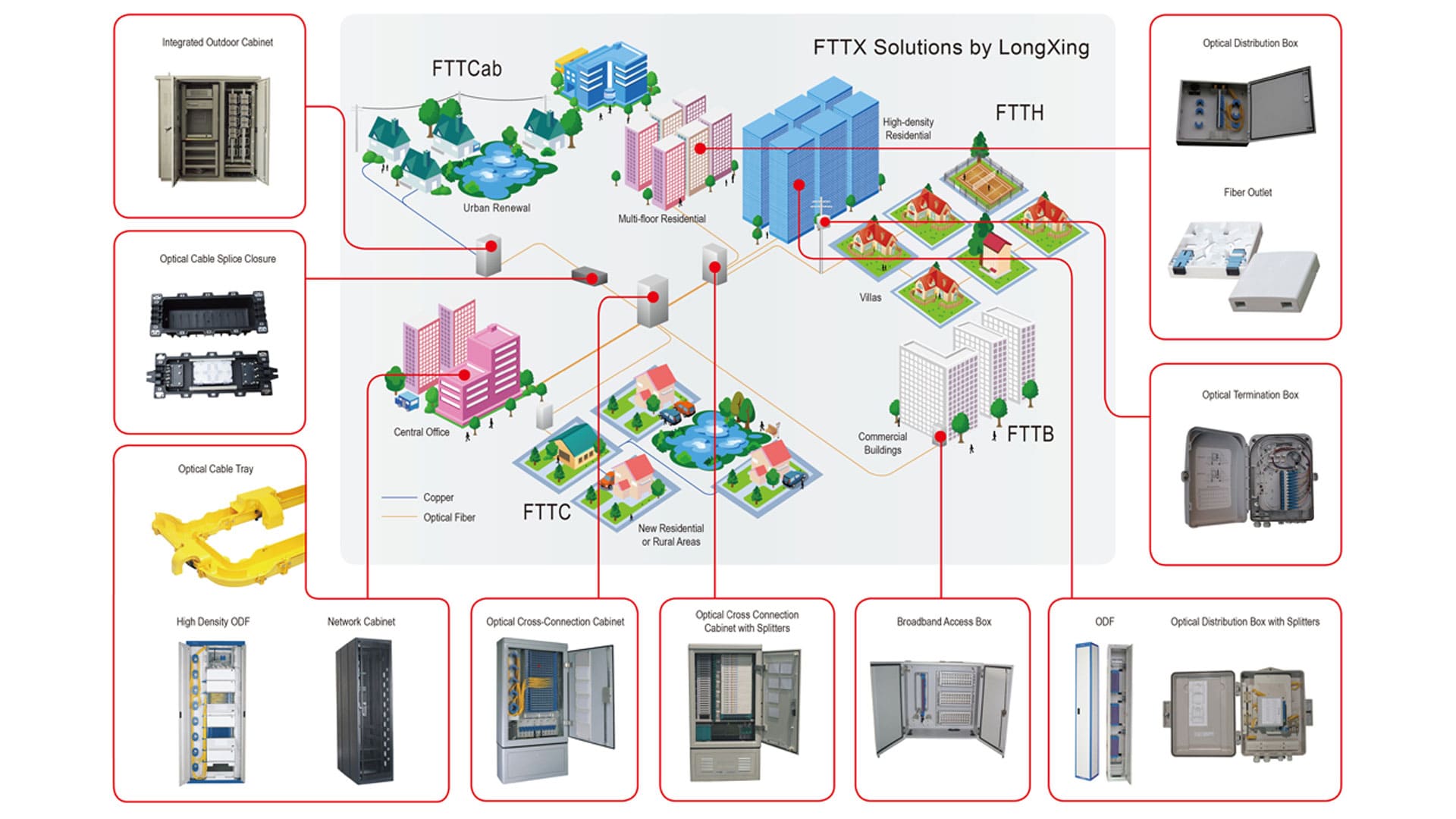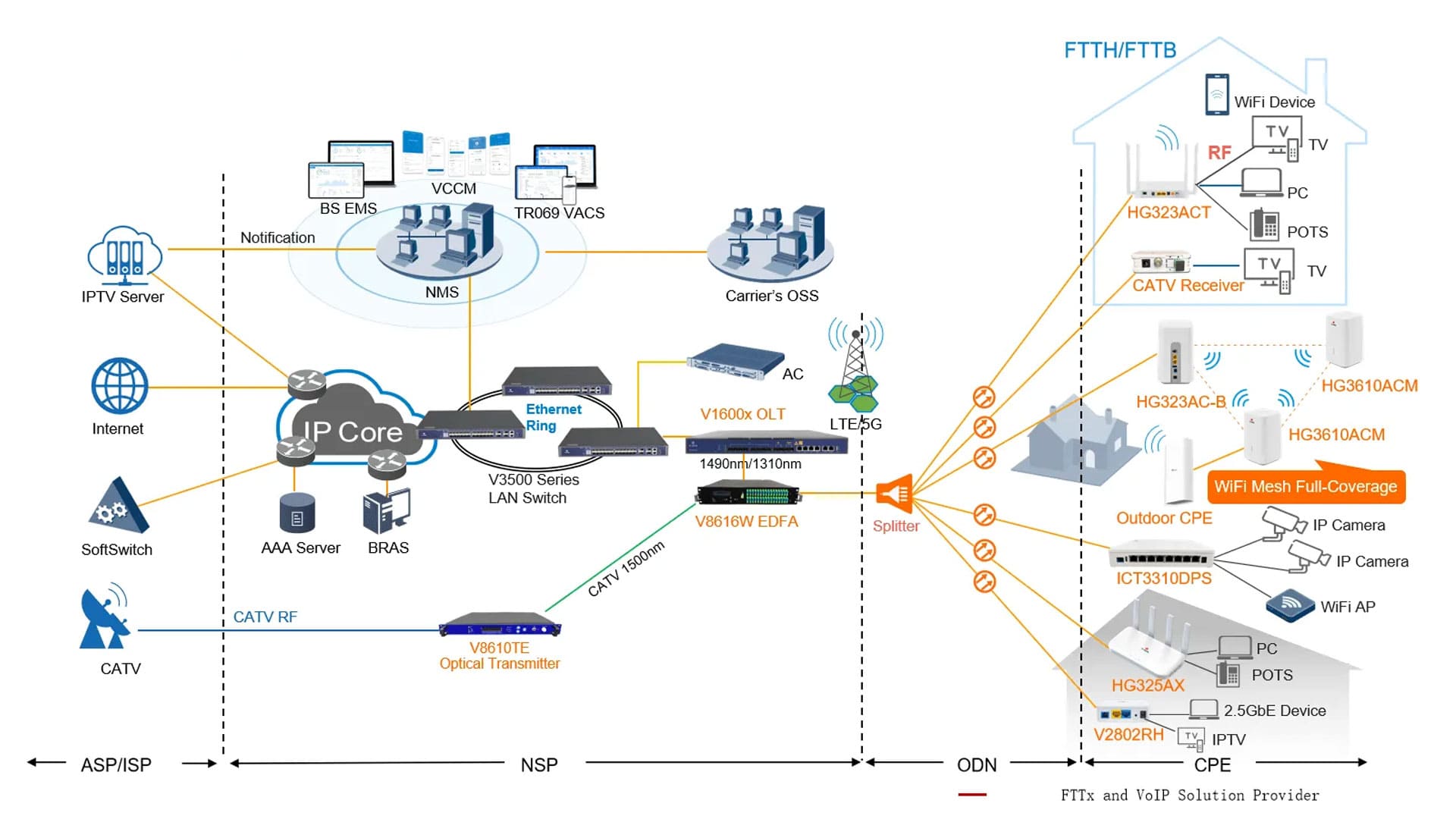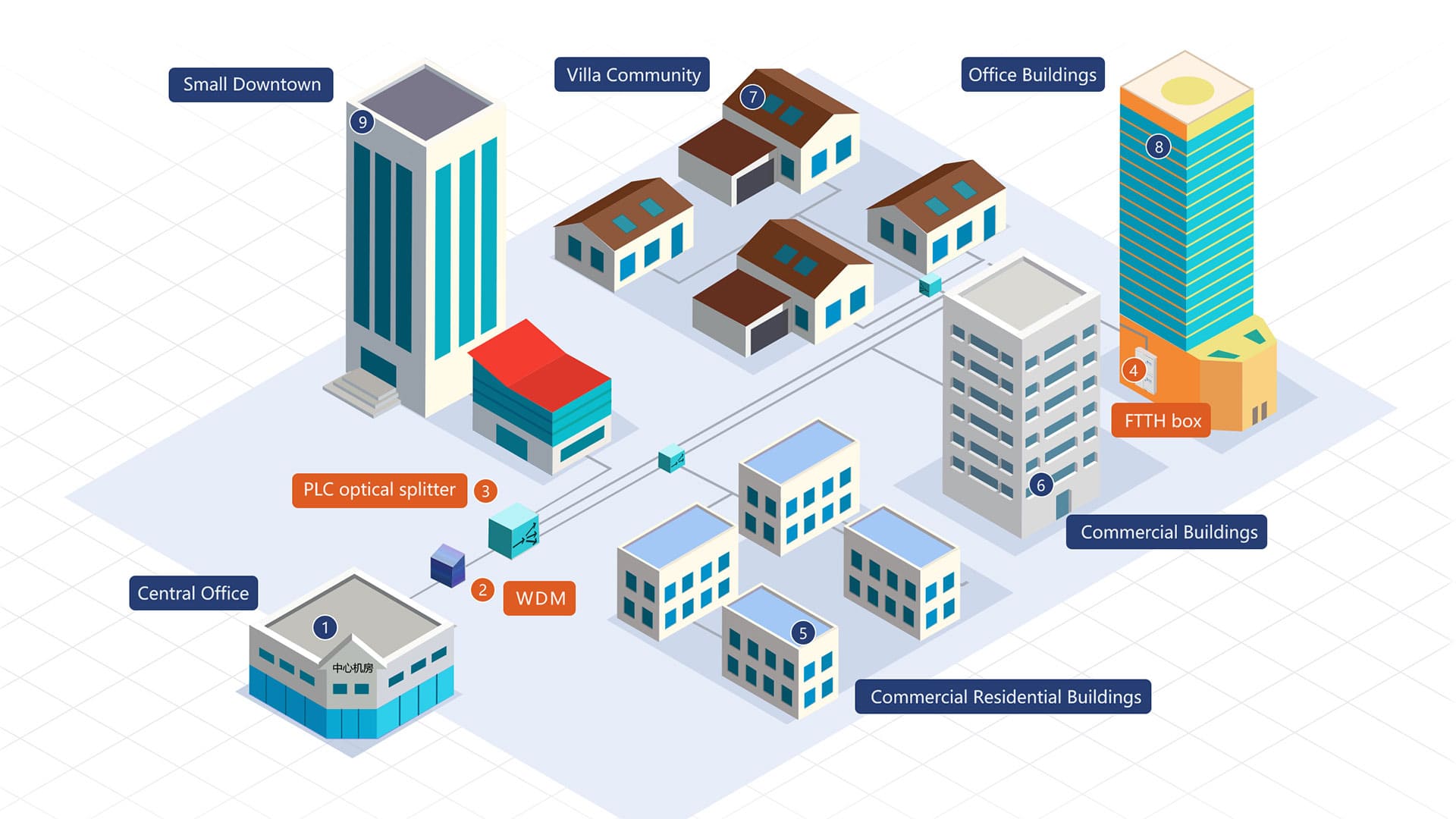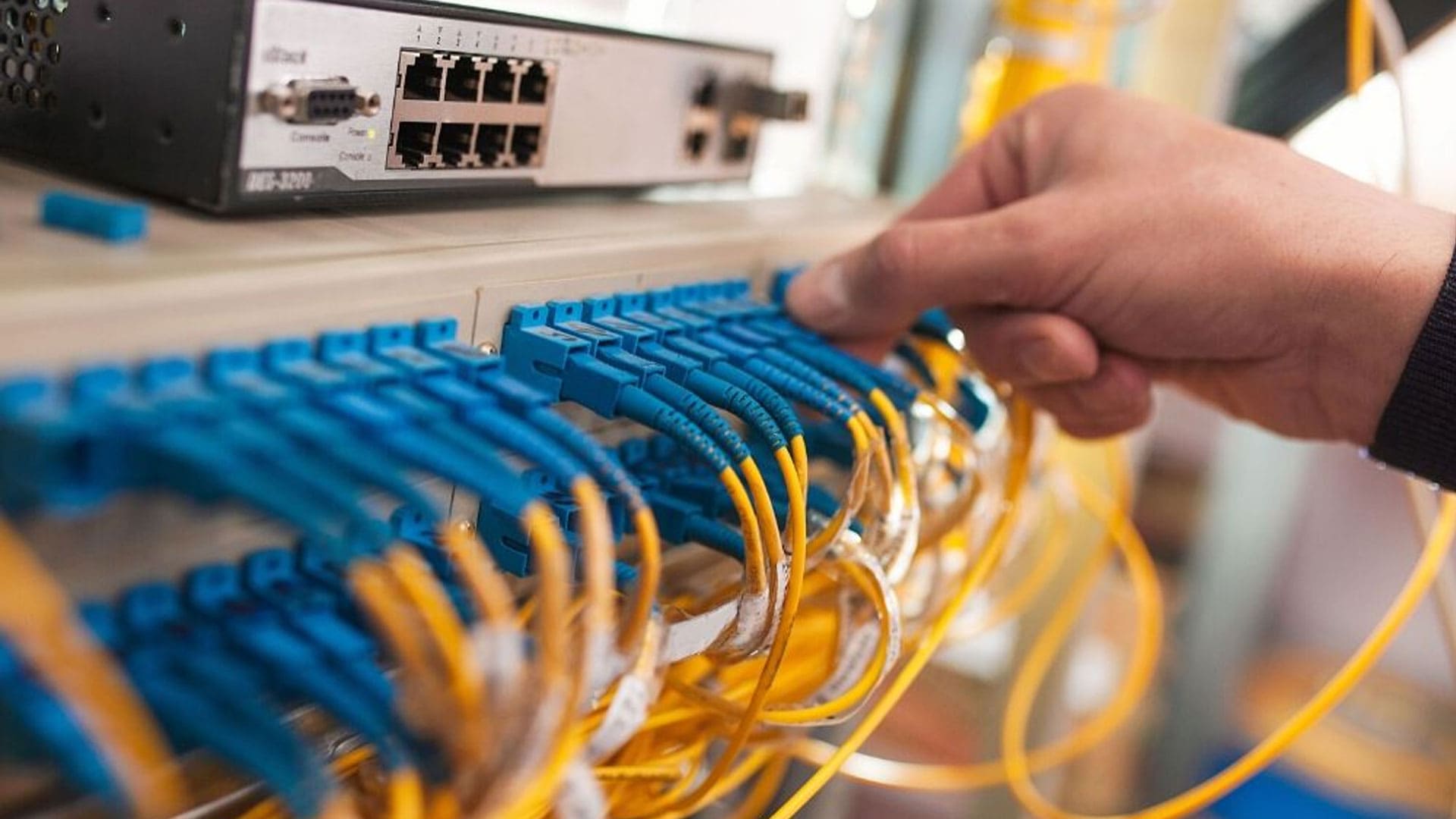In today’s hyper-connected world, fast and
reliable internet access has become essential for businesses, homes, and
individuals alike. One of the key technologies enabling this connectivity is
FTTx, a suite of optical fiber-based solutions that revolutionize how data is
transmitted. But what exactly does FTTx mean? How does its design and buildout
process work? In this article, we’ll dive deep into the intricacies of FTTx,
covering everything from its types to its design principles and implementation
strategies.

Understanding FTTx
FTTx stands for "Fiber to the X," where "X" represents various possible termination points for fiber optic cables. The term is a generic representation of various configurations in fiber optic networks. The different "X" designations represent how far the fiber goes toward reaching the end user.
The major types of FTTx include:
- FTTH (Fiber to the Home): Fiber reaches directly to residential homes.
- FTTP (Fiber to the Premises): Includes both FTTH and fiber reaching businesses or buildings.
- FTTB (Fiber to the Building/Business): Fiber terminates at a shared location, typically a building, with copper or other technologies completing the connection to each unit.
- FTTN (Fiber to the Node): Fiber reaches a local node, and the remaining distance is bridged using traditional copper or coaxial cable.
- FTTC (Fiber to the Curb): Fiber reaches the curb near users' premises, with copper taking the final step.
Each of these configurations is used based on network provider goals, geographic considerations, and cost constraints.

Key Components of FTTx Networks
FTTx networks are complex systems that require various components and technologies working in tandem. Some of the key elements of an FTTx network include:
- Optical Line Terminal (OLT): Located at the service provider’s central office, the OLT is responsible for managing all communications between the network and the end users.
- Optical Distribution Network (ODN): This is the infrastructure that transmits signals from the OLT to the Optical Network Units (ONUs) or Optical Network Terminals (ONTs) at the user’s end. It includes fiber cables, splitters, and distribution points.
- ONT/ONU: These devices are installed at the customer’s premises. They convert the optical signals from the fiber into electrical signals that the user’s devices can understand.
- Splitters: Passive devices that split the fiber signal from the OLT into multiple signals to serve multiple customers.

The FTTx Design Process
Designing an FTTx network is a detailed and technical process that requires meticulous planning and attention to local conditions. The goal is to deliver fast and reliable internet to as many users as possible while keeping costs manageable. Here’s a step-by-step breakdown of how the FTTx design process works:
- Feasibility Study: Before any design work begins, a feasibility study is conducted. This includes an analysis of the geographical area, user density, current infrastructure, and potential demand. Understanding these factors helps determine the most suitable FTTx architecture, such as FTTH or FTTN.
- Network Topology Selection: There are several ways to structure an FTTx network, and choosing the right topology is crucial. The two most common types are:
- Point-to-Point (P2P): Every user gets a dedicated fiber connection.
- Passive Optical Network (PON): Multiple users share a single fiber connection through the use of optical splitters, making it more cost-effective.
PONs are widely used in residential applications because they allow service providers to share expensive infrastructure while still delivering high speeds to customers.
- Fiber Route Planning: Once the topology is decided, the next step is planning the fiber routes. This includes determining the exact path the fiber cables will take from the central office (OLT) to the customer premises. Engineers must consider existing underground utilities, buildings, roads, and any obstacles that may impact construction.
- Component Placement: The locations of splitters, OLTs, ONTs, and other necessary components are strategically selected to optimize performance, reliability, and cost-efficiency. This stage also involves planning for redundant paths in case of failures to ensure minimal downtime for users.
- Bandwidth and Capacity Planning: Network designers must ensure that the system can handle both current and future bandwidth demands. They calculate the number of users each splitter can support, the maximum load on each fiber, and the capacity of the OLT to manage traffic without bottlenecks.
- Permitting and Regulation: Since fiber deployment often involves digging trenches or using utility poles, obtaining permits and ensuring compliance with local regulations is a critical part of the design process. Any delays in permitting can slow down the project significantly.

The Buildout Process
Once the design is finalized, the buildout process begins. This phase involves physically installing the fiber optic infrastructure and connecting users to the network. Here’s a breakdown of how the buildout works:
- Laying the Fiber: Depending on the design, fiber cables are either buried underground or strung along utility poles. Underground deployment requires trenching or horizontal directional drilling (HDD), while aerial deployment involves attaching the fiber cables to existing telephone or power lines.
- Installing the Splitters and Cabinets: Splitters are placed in strategic locations—typically in street cabinets or utility closets in buildings—where the signal from the OLT is distributed to multiple users. These cabinets must be weatherproof and secure to protect sensitive optical components.
- Connecting the ONTs/ONUs: At the user’s premises, ONTs or ONUs are installed to terminate the fiber connection and convert it into a usable data signal. This is often the final step in delivering fiber-to-the-home services, allowing users to connect their devices.
- Testing and Quality Assurance: After installation, each section of the network is tested to ensure it meets performance standards. Fiber optic testing involves checking signal strength, data integrity, and potential losses due to improper connections or bends in the cable.
- Activation and Service Delivery: Once the network passes quality checks, it is activated, and users can start receiving high-speed internet services. Providers typically offer tiered packages, with speeds ranging from basic to gigabit-level connections depending on the FTTx architecture in place.

Benefits of FTTx Networks
FTTx networks bring numerous advantages, which is why many regions and service providers are investing heavily in them:
- High-Speed Internet: FTTx networks provide speeds far surpassing traditional copper-based systems, making them ideal for high-bandwidth applications such as video streaming, online gaming, and remote work.
- Future-Proofing: Fiber optic technology is scalable, allowing service providers to increase speeds as demand grows without needing to replace the infrastructure.
- Lower Latency: Fiber networks offer low-latency connections, which are crucial for real-time applications like video conferencing, virtual reality, and cloud computing.
- Reduced Maintenance: Fiber optics are more durable and require less maintenance than copper lines, reducing the overall cost of network upkeep.

Challenges in FTTx Buildouts
Despite its benefits, building FTTx networks comes with challenges:
- Cost: Laying fiber infrastructure, especially in remote or rural areas, is expensive. The costs are compounded when digging underground, navigating difficult terrain, or acquiring permits.
- Time-Consuming: The buildout process can be slow, especially when dealing with dense urban areas or places with existing infrastructure that must be navigated or upgraded.
- Regulatory Hurdles: Obtaining the necessary permits and adhering to local regulations can delay projects and add to the costs of deployment.
FTTx networks are the future of internet
connectivity, offering unmatched speed, reliability, and scalability. Designing
and building these networks is a complex process that requires careful
planning, engineering, and investment, but the rewards are significant. As more
regions adopt fiber-based solutions, FTTx will continue to pave the way for the
next generation of digital services and innovations, ensuring that users have
access to the high-speed internet that modern life demands.
By understanding the principles behind FTTx design and buildouts, network engineers and decision-makers can better navigate the challenges of deploying these cutting-edge systems and capitalize on the opportunities they bring to communities and businesses alike.







































































